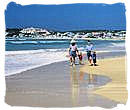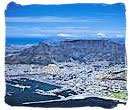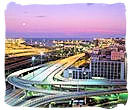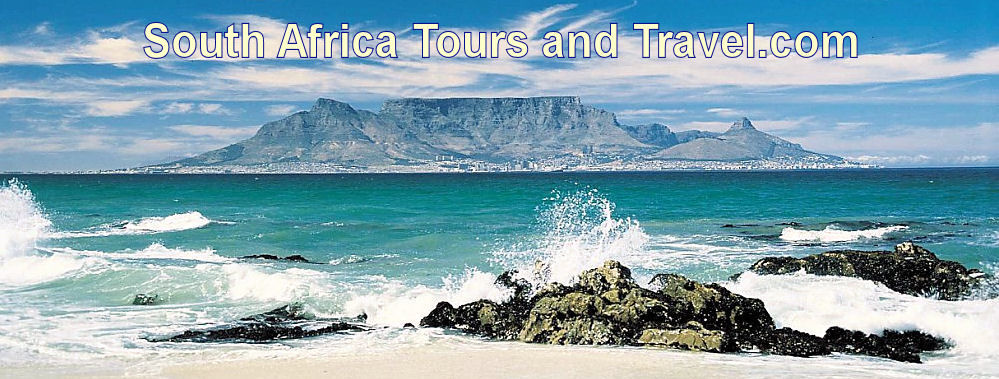 |
||||||||||
South Africa 's Infrastructure, The Facts
The country is also a prominent player on the shipping routes between the Indian and Atlantic oceans, acting as a stopover between Europe, Asia, Australasia and both coasts of Africa, with many Major shipping lines routing their ships along the South African coastline and around the most southern tip of Africa. Let's face it, getting to South Africa involves a long flight, especially from the States, but it is well worth it. Planning your trip is easy enough; over 50 international airlines fly here, either directly or through connected flights. You will most likely arrive at the biggest gateway airport, OR Tambo, in Johannesburg. But international flights also land at the multi-award winning and picturesque Cape Town International airport. From there on visitors will usually do most of their by car or bus, using the country's excellent and extensive asphalt highways and national roads system. In the rural areas you will also find gravel roads though, but these are well maintained and easy to negotiate. Please note that:
The following is a selection of the information that can be found on this page:
The Airports,...South Africa is home to 9 major airports, comprising 3 international ones, which are O.R. Tambo International airport at Johannesburg, Cape Town International airport, King Shaka International airport at Durban and 6 domestic ones and they are Port Elizabeth airport, Bram Fisher airport at Bloemfontein, East London airport, George airport, Kimberley airport and Upington airport. These airports are all equipped with the latest high-tech facilities and measure up with the best in the world. The domestic airlines that operate regular flight schedules between these airports are South African airways, South African Airlink, South African Express, British Airways, Mango airways, Kulula Airways and SafAir Airways who arrived on the Domestic airline scene only recently. Among these 7 airline companies South African Airways is the national airline carrier, while Mango, Kulula and SafAir can be regarded as the price fighters among them.
An Airbus 380 airplane at OR Tambo International Airport
Situated at Kempton Park (Ekurhuleni), about 33 km or a 30 minutes drive away from Johannesburg, O.R. Tambo International Airport is South Africa's major airport and most likely the one where you will arrive when coming to visit South Africa. Known as Palmiet International Airport as early as 1945 when it started handling flights to and from Europe, it was renamed Jan Smuts International Airport in 1952 after general Jan Smuts, South Africa's prime minister during the 2nd world war years. With the departure from the Apartheid years and the start of a new democracy it was again renamed in 2006 after O.R. Tambo, president of the African National Congress during the struggle for freedom from Apartheid. 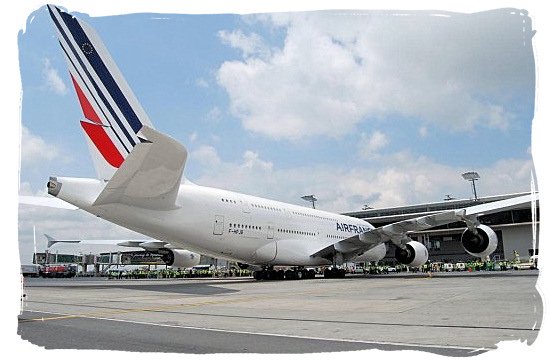
 An Airbus 380 airplane at OR Tambo International Airport
An Airbus 380 airplane at OR Tambo International AirportSituated at Kempton Park (Ekurhuleni), about 33 km or a 30 minutes drive away from Johannesburg, O.R. Tambo International Airport is South Africa's major airport and most likely the one where you will arrive when coming to visit South Africa. Known as Palmiet International Airport as early as 1945 when it started handling flights to and from Europe, it was renamed Jan Smuts International Airport in 1952 after general Jan Smuts, South Africa's prime minister during the 2nd world war years. With the departure from the Apartheid years and the start of a new democracy it was again renamed in 2006 after O.R. Tambo, president of the African National Congress during the struggle for freedom from Apartheid. The Ports,...There are 8 major commercial Ports in South Africa. State-owned and run by the Transnet National Ports Authority (NPA), they are Richards Bay and Durban in KwaZulu-Natal, Port Elizabeth, East London and the Port of Ngqura in the Eastern Cape and Mossel Bay, Cape Town and Saldanha Bay in the Western cape. Ngqura is Africa's Deepest container terminal. Durban is the busiest Port and largest container facility in Southern Africa, while Richard's Bay is the world's largest bulk coal terminal.
Cruise ship "The World" in the harbour of Cape Town
Situated at the southern tip of the African Continent on one of the world's most active trade routes, the Port of Cape Town was established by the Dutch East India Company in 1652 as a refreshment and supply station for their ships voyages to and from the Dutch East Indies. It has since developed into the 2nd largest port in South Africa after Durban. The development of its Victoria and Alfred basins in to a huge shopping, dining and entertainment center with the iconic Table Mountain as backdrop, has turned it into one of the most beautiful harbours in the world. 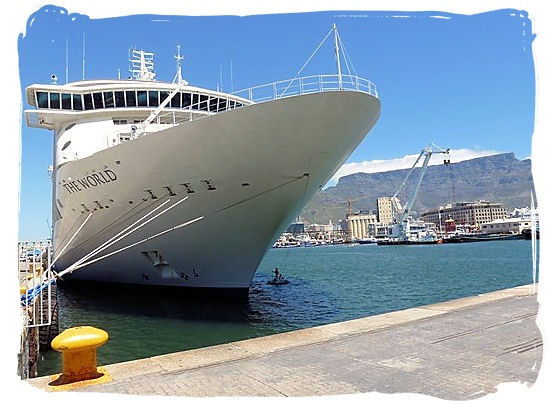
 Cruise ship "The World" in the harbour of Cape Town
Cruise ship "The World" in the harbour of Cape TownSituated at the southern tip of the African Continent on one of the world's most active trade routes, the Port of Cape Town was established by the Dutch East India Company in 1652 as a refreshment and supply station for their ships voyages to and from the Dutch East Indies. It has since developed into the 2nd largest port in South Africa after Durban. The development of its Victoria and Alfred basins in to a huge shopping, dining and entertainment center with the iconic Table Mountain as backdrop, has turned it into one of the most beautiful harbours in the world. copyright © south africa tours and travel.com The Railways,...As the 14th longest in the world, South Africa's rail infrastructure includes an extensive railroad network, connecting its Ports not only with destinations within the country, but also with the whole of Sub-Saharan Africa. The network includes 21 000 km of railroads of which 1500 km are designated for heavy haulage and of which a total of 8 200 km has been electrified. The number of people that travel by train every day lies around the 2.2 million. The vast majority of them are commuters in the metropolitan areas who use the Metrorail commuter services. Shosholoza Meyl rail services operates train services between the country's major cities. Latest addition to South Africa's railroad infrastructure is the Gautrain, a high-speed train traveling at 160km/hr that operates between O.R. Tambo International Airport and the cities of Johannesburg and Pretoria.
The Gautrain
In effort to reduce the unmanageably high traffic density levels within the Gauteng area, the Gautrain high speed railway system was put into operation in 2011. It comprises a network of 80 km (50 miles) network linking Pretoria, Ekurhuleni (previously the East Rand), Johannesburg and OR Tambo International Airport. Traveling at up to 160 km/hr, the train covers the Pretoria distance in 35 minutes and the Sandton (Johannesburg) OR Tambo Airport distance in 15 minutes. 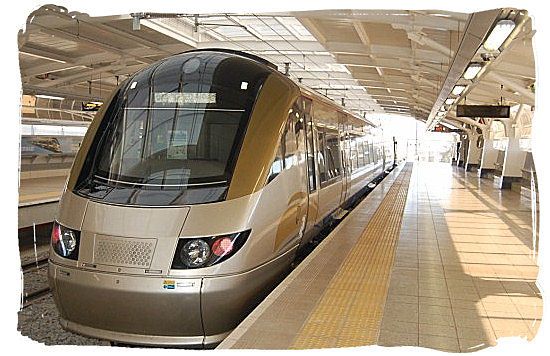
 The Gautrain
The GautrainIn effort to reduce the unmanageably high traffic density levels within the Gauteng area, the Gautrain high speed railway system was put into operation in 2011. It comprises a network of 80 km (50 miles) network linking Pretoria, Ekurhuleni (previously the East Rand), Johannesburg and OR Tambo International Airport. Traveling at up to 160 km/hr, the train covers the Pretoria distance in 35 minutes and the Sandton (Johannesburg) OR Tambo Airport distance in 15 minutes. copyright © Nithin bolar k The Roads,...The entire network of roads in South Africa comes to a total of 747,000 kilometres, classified as follows;
Read more about South Africa's roads infrastructure >>
Highways intersection at Port Elizabeth, South Africa
The total road network in South Africa comprises a huge total of 76,000 km of roads, of which 10,000 km form a fully tar-surfaced national road network of multi lane highways and freeways. Connecting the country's major cities, they have been designed and built during the 1970's and 80's, based on the United States Interstate Highway network as model. 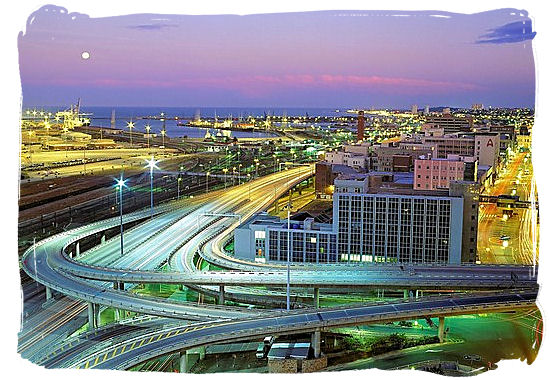
 Highways intersection at Port Elizabeth, South Africa
Highways intersection at Port Elizabeth, South AfricaThe total road network in South Africa comprises a huge total of 76,000 km of roads, of which 10,000 km form a fully tar-surfaced national road network of multi lane highways and freeways. Connecting the country's major cities, they have been designed and built during the 1970's and 80's, based on the United States Interstate Highway network as model. copyright © south african tourism The Electricity,...Years of neglect of the South Africa's electrical power infrastructure, especially in the black population areas during the apartheid years, had led to a situation of a large imbalance between a seriously underdeveloped power infrastructure in the areas mentioned and a well developed one in the more prosperous metropolitan and industrialized parts of the country. Economical development and empowerment of the Country's third world component created a demand for electrical energy rising so fast, that it exceeded the present state owned supply capabilities by far. A serious threat to the country's overall growth potential. To get things back into balance the government has embarked on a massive electrification program, involving an investment of 340 billion Rand. Generally speaking, tourists and visitors will experience a well developed and sophisticated electrical power supply network comparable with the best in the world. The one thing they may encounter is the concept of load shedding, an action whereby during periods when electricity demand exceeds supply capability, the overload is reduced by temporary interrupting supply to certain areas. This is done on a national basis. What it means is, that during peak periods the electricity supply will be cut off for 1 to 2 hours every so often, which can vary from once a day to once per number of days or even weeks.
Network of electricity pylons and cables in the Orange Free State province
Generated by large power stations all over South Africa and transmitted by a huge network of pylons and cables, electricity is available almost everywhere in the country except maybe for only a few very remote rural areas. The national supplier is Eskom, a semi-government institution. Electrical power is supplied at is 220/230 volts and AC 50 HZ. 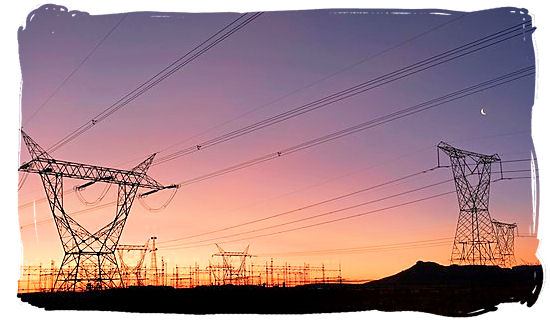
 Network of electricity pylons and cables in the Orange Free State province
Network of electricity pylons and cables in the Orange Free State provinceGenerated by large power stations all over South Africa and transmitted by a huge network of pylons and cables, electricity is available almost everywhere in the country except maybe for only a few very remote rural areas. The national supplier is Eskom, a semi-government institution. Electrical power is supplied at is 220/230 volts and AC 50 HZ. copyright © Photo: Chris Kirchhoff, MediaClubSouthAfrica.com The Telecommunications,...Powered by the meteoric development and growth of mobile telecoms and high speed broadband connectivity, telecommunications is one of the fastest growing industries in South Africa. With the latest in satellite, wireless and fixed-line technology, the country's telecoms network is almost 100% digital and can be compared with the best in the world There are two fixed-line or land-line operators, Telkom and Neotel, who provide telephone services to residential, office and other establishments, including an extensive public call box network country wide. Home Direct (charging a call to your home number) and Reverse Charge services are also available. The five mobile network operators are Vodacom, MTN, 8ta, Cell C and Virgin Mobile. They offer mobile telephone services country wide. Coverage and reception is usually very good in urban and coastal areas. Air time and Sim cards are readily available at all retail outlets, petrol stations and post offices from as little as R1-00. Internet access is widely available in South Africa. Most accommodation establishments such as Hotels, Guest Houses and B&B's offer Wifi internet connections. In addition there are numerous internet cafes throughout the metropolitan and larger urban areas. Most of them offer a high speed ADSL land-line dial up connection at very reasonable rates. Picture Gallery,…
Activity on the apron of Cape Town International Airport
Previously known as D.F. Malan Airport, named after one of South Africa's former prime ministers, Cape Town International Airport is the 2nd largest airport in South Africa, after O.R. Tambo Airport and the third largest in Africa. It is situated only 20 km from Cape Town's city center, offering direct flights to a variety of destinations in Europe, Asia and Africa. The Airport underwent a large scale expansion and renovation in 2010 including a new central terminal building. In 2014 its total number of passengers processed came to figure of 8,6 million. 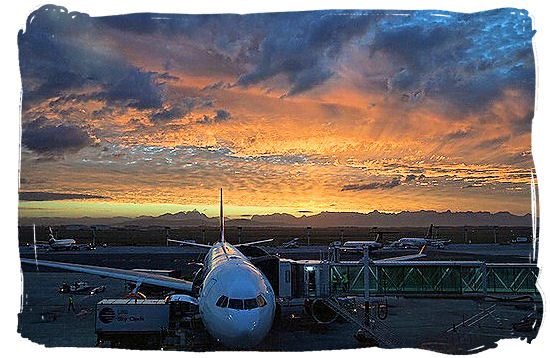
 Activity on the apron of Cape Town International Airport
Activity on the apron of Cape Town International AirportPreviously known as D.F. Malan Airport, named after one of South Africa's former prime ministers, Cape Town International Airport is the 2nd largest airport in South Africa, after O.R. Tambo Airport and the third largest in Africa. It is situated only 20 km from Cape Town's city center, offering direct flights to a variety of destinations in Europe, Asia and Africa. The Airport underwent a large scale expansion and renovation in 2010 including a new central terminal building. In 2014 its total number of passengers processed came to figure of 8,6 million. copyright © Kenny B, www.spofode
Oil rigs and drilling ships are often seen in the harbour of Cape Town, where servicing and
refurbishing of oil installations has become big business.
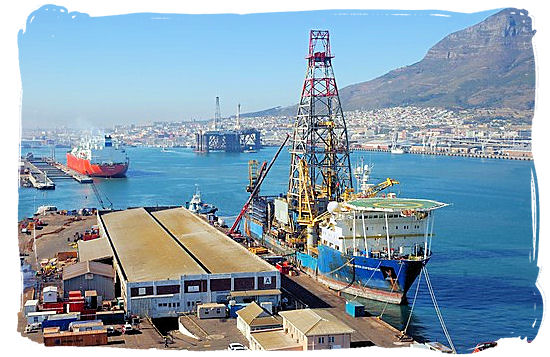
 Oil rigs and drilling ships are often seen in the harbour of Cape Town, where servicing and
refurbishing of oil installations has become big business.
Oil rigs and drilling ships are often seen in the harbour of Cape Town, where servicing and
refurbishing of oil installations has become big business.copyright © Photo: Rodger Bosch, MediaClubSouthAfrica.com
The 42 meters high pylon of the Nelson Mandela Bridge in Johannesburg
4000 m3 of concrete, 1000 tons of structural steel and 500 tons of reinforcement steel went into the construction of the already iconic Nelson Mandela bridge in Johannesburg. Named in honour of South Africa's world famous first democratically elected president, the Bridge is 284 meters long, 42 meters high at its northern pylon and 27 meters high at its southern pylon. The purpose of building it was to link the two main business areas of Johannesburg, namely Braamfontein and Newton spanning the railway emplacement between them. 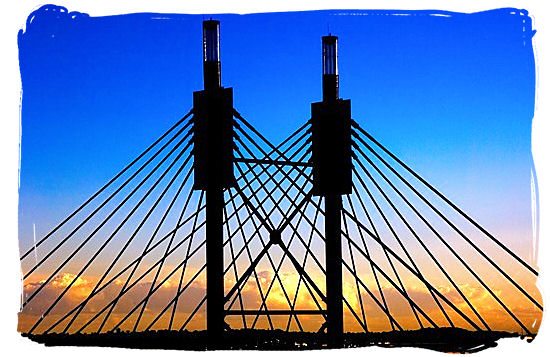
 The 42 meters high pylon of the Nelson Mandela Bridge in Johannesburg
The 42 meters high pylon of the Nelson Mandela Bridge in Johannesburg4000 m3 of concrete, 1000 tons of structural steel and 500 tons of reinforcement steel went into the construction of the already iconic Nelson Mandela bridge in Johannesburg. Named in honour of South Africa's world famous first democratically elected president, the Bridge is 284 meters long, 42 meters high at its northern pylon and 27 meters high at its southern pylon. The purpose of building it was to link the two main business areas of Johannesburg, namely Braamfontein and Newton spanning the railway emplacement between them. copyright © Photo: Chris Kirchhoff, MediaClubSouthAfrica.com
The PetroSa gas and oil refinery at Mossel Bay
Established in 2002, PetroSa (The Petroleum, Oil and Gas Corporation of South Africa SOC Ltd.) owns and operates the first and currently the 3d largest gas-to-liquid (GTL) refinery complex in world. Situated in Mossel Bay, the company is involved in exploiting the offshore natural gas and oil fields near Mossel Bay, from which it produces a variety of liquid fuels and chemicals. 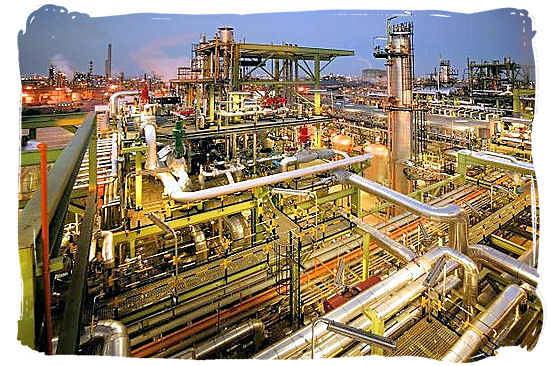
 The PetroSa gas and oil refinery at Mossel Bay
The PetroSa gas and oil refinery at Mossel BayEstablished in 2002, PetroSa (The Petroleum, Oil and Gas Corporation of South Africa SOC Ltd.) owns and operates the first and currently the 3d largest gas-to-liquid (GTL) refinery complex in world. Situated in Mossel Bay, the company is involved in exploiting the offshore natural gas and oil fields near Mossel Bay, from which it produces a variety of liquid fuels and chemicals. copyright © Photo: Rodger Bosch, MediaClubSouthAfrica.com
The FNB stadium, also called Soccer City between Johannesburg and Soweto
Built during the 1980's the FNB soccer stadium was comprehensively upgraded in preparation for the 2010 soccer world cup in 2009, making it the largest stadium on the African continent. Situated about 8 km south-west of Johannesburg's CBD and about 9 km north-east of Soweto city center, the stadium is now commonly known as Soccer City. With the seats capacity increased from 80,000 to 90,000 it hosted the opening and closing ceremonies of the 2010 soccer world cup, including the finals between Holland and Spain. 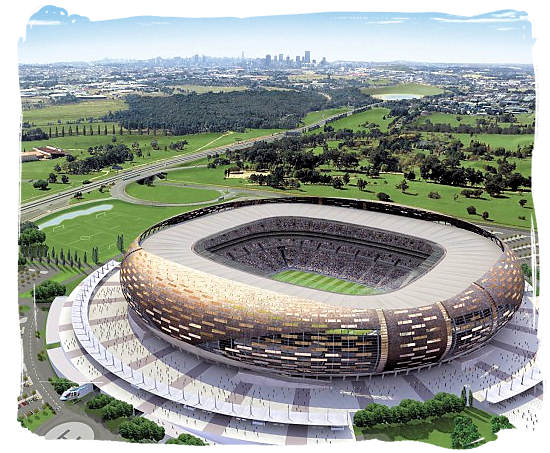
 The FNB stadium, also called Soccer City between Johannesburg and Soweto
The FNB stadium, also called Soccer City between Johannesburg and SowetoBuilt during the 1980's the FNB soccer stadium was comprehensively upgraded in preparation for the 2010 soccer world cup in 2009, making it the largest stadium on the African continent. Situated about 8 km south-west of Johannesburg's CBD and about 9 km north-east of Soweto city center, the stadium is now commonly known as Soccer City. With the seats capacity increased from 80,000 to 90,000 it hosted the opening and closing ceremonies of the 2010 soccer world cup, including the finals between Holland and Spain. copyright © Photo: MediaClubSouthAfrica.com Video Gallery,…Top of Page |
|
|||||||||
|
|
||||||||||









